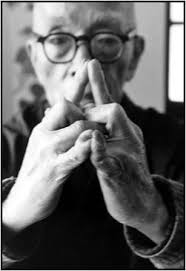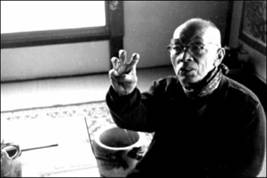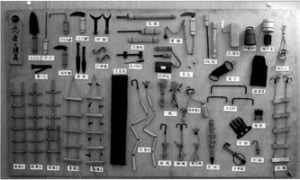The Togakure Ryu (the school of the Hidden Door) is one of the oldest ninja schools still in existence. Supposedly there were more than 70 ninja schools at one time, most of which have died out, but they were all greatly influenced by the techniques and skills of the Togakure Ryu.
Togakure itself was made up of a variety of martial arts near the end of the 12th Century, by its founder Daisuke Nishina, who later changed his name to Togakure, the village where he originated. In fact it was not just influenced by other martial arts, but by the education, culture and understanding of migrant Chinese, Koreans, ascetics, Buddhist monks, Taoists, farmers, robbers, pirates, magicians and all mannerisms of the peculiar and persecuted by the conservative Japanese.
Daisuke Nishina was a Samurai retainer of Minamoto no Yoshinaka, from Nagano, a General who captured Kyoto in 1182. However, as soon as he had done this, the General was then attacked and defeated by his cousin, Yoshitsune. Daisuke Nishina was badly wounded by this attack, but he was rescued by a Kain Doshi, who he fleed with to the Mountains of Iga to hide to avoid capture. Once healed, he devoted himself to Kain Doshi who taught him a variety of martial arts. Here, changing his name to Togakure, Daisuke founded the school of Togakure and consequently over the years, Iga, became one of the two most prolific areas of ninpo (the other being Koga).

Among the nine schools of the Bujinkan, Togakure-ryū is one that has less information, the one that a lot of people believe is not legitimate, but it was the first one that Hatsumi sensei presented, more than Gyokko-ryū, Kotō-ryū, Takagi Yōshin-ryū, etc… when he first brought his budo to the public arena. We already have the proof and existence of the name of the village, Togakure, in the 7th century. This place was known to have many caves and waterfalls where monks, hermits, or ascetics would go to train, and also warriors who were looking for places to hide, such as Daisuke Nishina.
In fact the name of the school only started to be used as a name possibly six or seven generations after the foundation of the ryūha. Of course it’s the name of a village, which means the “hidden door” or the “door that hides something”. This tells you all you need to know about the type of movement needed in this school. It has to be something that no one can see, as well as seeing what the enemy is hiding, whether it is a weapon, strategy or a weak point, whilst at the same time, create a door for which to hide things yourself. This is the depth of Togakure-ryū, and it is why it has many hidden weapons, and the movemnet is hard to show, let alone to write down in a densho!
When Takamatsu sensei began studying under Toda sensei, he was nine years old. At this age one can at least walk pretty competently. Yet the first thing Toda supposedly taught Takamatsu was the art of walking from Togakure-ryū, then later he began with the better known Gyokko-ryū. But it was this specific way of walking that would teach Takamatsu how to make all the techniques become invisible.

Hence, Togakure-ryū is very hard to catch, or to show, but at the same time it has Kosshijutsu, Koppōjutsu, and Dakentaijutsu within it. Unlike in Gyokko-ryu, where an aspect of the school is that the hand is closed and when you strike, you open the hand, and in Koto-ryu, the hand is open, and at the impact, you close the hand, in Togakure-ryu the hands are always open. The hands are open because you have the shukō (hand claws). Shukō were not weapons for war, they were a tool for carrying things like bales of hay. So what happened was that a warrior would have been working in the fields, but then was suddenly attacked by someone and he used the tools by accident, but with success, and suddenly techniques with Shuko were born!
Obviously walking around with shukō today is stupid; for one its illegal, it’s too big, and there are things far better, smaller, and more effective. However, you may fine yourself in a similar situation, where someone attacks you on the street and all you have in your hand is your house or car keys. Suddenly, an ancient form of defence that seems antiquated and outdated, suddenly has relevance. Understanding the ways of moving and the details of such things as open hands because of the weapon, not only gives context to the movement, but actually provides a wealth of opportunities as a result.

There were many ingenious weapons used by the ninja, which like the Shuko, were originally just farm tools or weapons that were modified to give the advantage. The Togakure ryu was known to incorporate the use of the Ninja-to (long handled short sword for better leverage against greater opponents), Shinodake (blow pipe, which also seconded as a breathing apparatus under water), Bisento (a ridiculously heavy pole arm used for ramming and felling), Kyoketsu/Shogei/Kusarigama (chains or rope with weight and hooks either end), Bo Shuriken (various single and double pointed throwing rods), Metsubushi (blinding powder), Teppan (blunt iron plate throwing stars), Senban (sharp throwing stars), Kunai (an iron digging trowel for beating & stabbing) and the Yari (spear). However, the majority of the school’s techniques are about escape, evasion and ways of influencing the opponent. One of the main credences of Ninpo is to avoid violence whenever possible, and that you should ‘carry the sword’ (any weapon, including yourself) peacefully. It should only be used to protect country, family, nature and, of course, you.
In Togakure-ryū, there is no Shoden, Chūden, and Okuden as there are in other schools we practice. There is only a progression through the techniques and that is it. Ninpo, as well as being the art of stealth (or to hide as we have just explored) also means the way of endurance. The purpose of the ninja is to tolerate even the most extreme and bizarre of situations, to survive, to keep going (Gambatte). It is this understanding that is at the heart of the Togakure Ryu training.